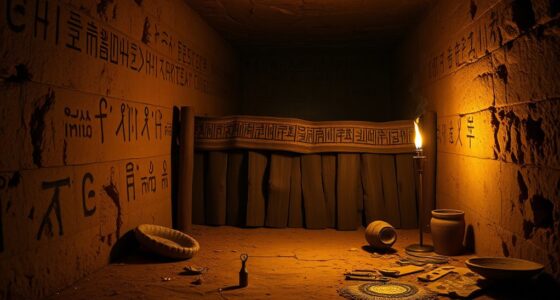Ancient Egypt’s tombs are often shrouded in tales of curses, primarily fueled by the sensationalized media following the discovery of King Tutankhamun’s tomb in 1922. While ancient Egyptians focused on protection and safeguarding legacies, myths of curses gained traction, reflecting societal fears and colonialistic narratives. Notable deaths linked to tomb explorations added to the allure, yet scientific perspectives debunk these supernatural claims. Curious about the impacts and other infamous tales? There’s much more to uncover.
Key Takeaways
- Ancient Egyptians used protective measures in tombs, focusing on safeguarding legacies rather than cursing intruders.
- The myth of tomb curses gained traction after the discovery of Tutankhamun’s tomb in 1922 and sensationalized media coverage.
- Notable figures like Lord Carnarvon experienced mysterious deaths, fueling public fascination with the supposed curse linked to King Tut’s tomb.
- No actual curses were inscribed in Tutankhamun’s tomb; deterrent inscriptions were more common in private tombs.
- Modern science dismisses the curse narratives, attributing health issues and deaths to natural causes rather than supernatural threats.
The Legend of Cursed Tombs: Origins and Impact
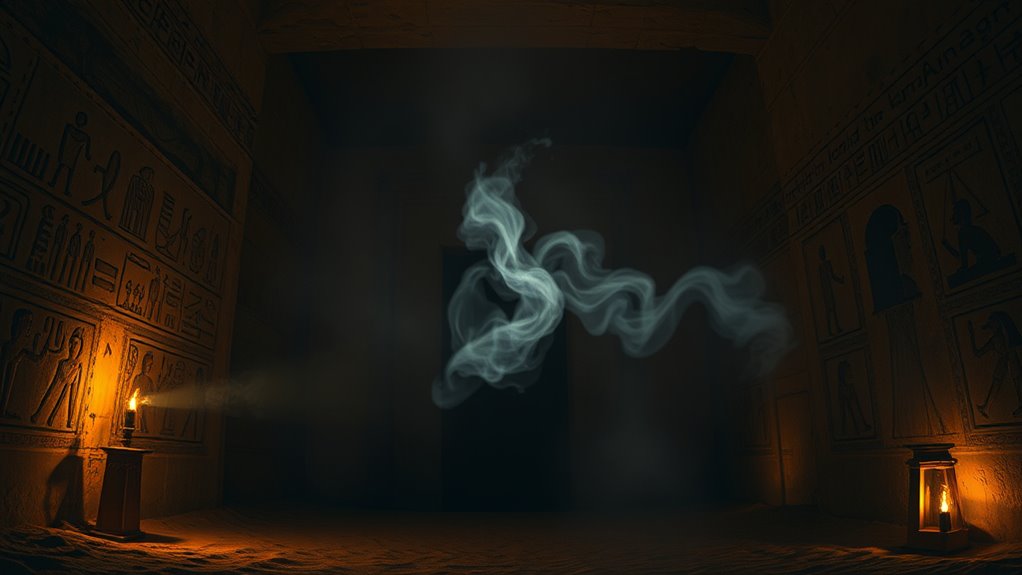
While many believe in the allure of cursed tombs, the reality behind these legends is far more complex. Ancient Egyptians didn’t inscribe curses in their tombs; instead, they employed magic and rituals to assist the deceased in the afterlife. This use of magic and rituals reflects their deep-seated beliefs about the interconnectedness of life and death.
The notion of mummy curses emerged primarily in the 19th century, fueled by Victorian fascination with the supernatural. After the discovery of Tutankhamun’s tomb in 1922, sensational media coverage captured public imagination, solidifying these myths in popular culture. The opening of the tomb led to rumors of a curse associated with King Tut.
These tales often reflect colonialism’s darker aspects, rather than any genuine belief in curses. Today, the legend of cursed tombs continues to thrive in literature and film, highlighting the enduring mystique of ancient Egyptian culture while lacking historical grounding.
King Tutankhamun: The Most Notorious Curse

As the discovery of King Tutankhamun’s tomb enthralled the world in 1922, whispers of a curse soon emerged, igniting fear and fascination. The narrative gained traction after Lord Carnarvon’s death just weeks later, fueling claims of a deadly curse.
Curiously, ancient Egyptians didn’t believe in cursing tombs; their focus was on protection. Sensationalized newspaper reports fed the myth, suggesting inscriptions warned against disturbances, like “Death will slay with his wings whoever disturbs the pharaoh.” However, these tales are likely apocryphal. Despite the lack of evidence, the idea of a curse became woven into the tomb’s folklore, enthralling audiences and ensuring that King Tutankhamun’s legacy remains shrouded in mystery and intrigue. Interestingly, modern science suggests the curse is a myth, fueled by superstition and sensationalism. In fact, the notion of a curse is reminiscent of how gold investments can also be subject to myths and misconceptions surrounding their value and risks. Furthermore, the sensationalism surrounding King Tutankhamun’s tomb reflects how misdiagnosis is common in mental health, often leading to misunderstandings about the true nature of conditions like BPD. Notably, the emotional damage caused by these virtual affairs can mirror that of physical infidelity, illustrating the depth of betrayal felt by those affected. Additionally, the fascination with curses often parallels the way people misunderstand IRA inheritance rules, which can lead to unintended financial consequences. Moreover, the stories of curses surrounding tombs highlight the impact of public awareness on historical narratives and cultural perceptions.
Other Notable Cursed Tombs of Ancient Egypt

Throughout ancient Egypt, numerous tombs beyond King Tutankhamun’s have been steeped in tales of curses, enchanting both historians and adventurers alike. One notable example is Khentika Ikhekhi’s tomb, which warns of dire judgment for those who disturb its peace. Similarly, Ankhtifi’s tomb features inscriptions that invoke local deities to protect inheritance rights. Many of these curses aimed to guarantee a safe afterlife for the deceased rather than simply deterring grave robbers. Genuine ancient curses are often rare and focus on protecting the deceased’s resting place. Spiritual principles are reflected in the way these curses emphasize the importance of honoring the dead. Additionally, the belief in compassion in patient care echoes through these ancient texts, suggesting that even in death, respect for the deceased was paramount. As explorers and archaeologists have uncovered these tombs, they have often been met with the thrill of discovery that reveals much about the beliefs and practices of ancient Egyptians. During British colonial times, the discovery of such tombs attracted massive public attention, turning them into major tourist attractions. Each curse reflects ancient Egyptian beliefs, adding to the mystique and complexity of their rich cultural heritage. Haunted folklore surrounding these tombs often intertwines with local legends, revealing much about their rituals and superstitions. Exploring these tombs reveals much about their rituals and superstitions, including the significance of sound healing practices believed to have been used in ancient rituals.
The Myths Behind the Curse: Historical Context
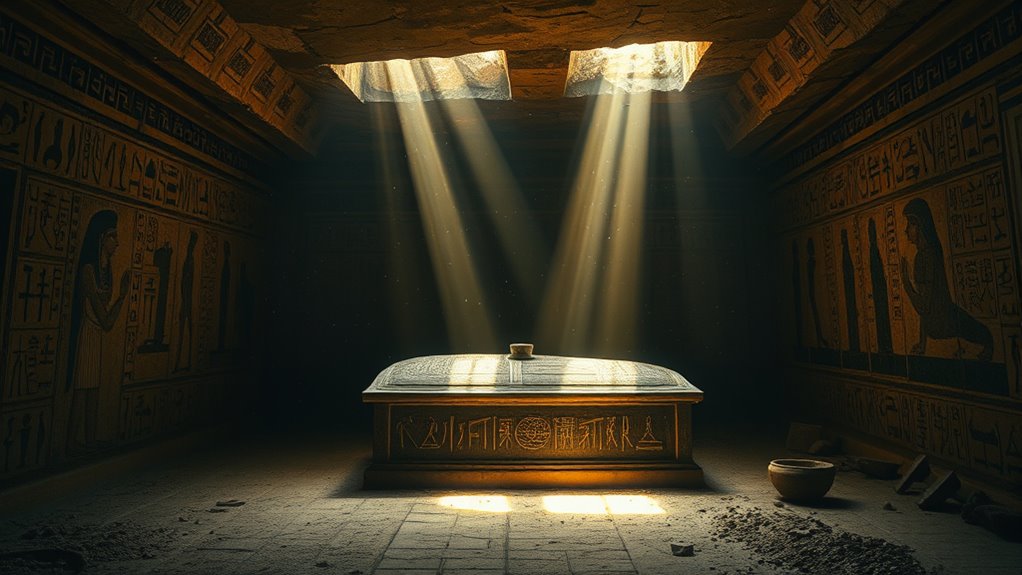
The myths surrounding tomb curses, particularly those of ancient Egypt, have deep historical roots that intertwine with cultural beliefs and societal changes.
While no curses were inscribed in Tutankhamun’s tomb, they often appeared in private tombs during the Old Kingdom to deter thieves through implied divine retribution. King Tutankhamun’s tomb was later discovered in the Valley of the Kings, further fueling the narrative of a curse associated with his burial site. Additionally, the concept of advance directives in ancient cultures reflected a profound understanding of the afterlife, paralleling the protective measures taken in tombs. The fear of emotional manipulation often influenced how ancient Egyptians approached the afterlife, emphasizing the importance of safeguarding their legacies. Moreover, ancient Egyptians believed in the power of magic and ritual to protect their tombs from desecration, which contributed to the development of curse narratives. The use of natural materials in tomb construction also played a role in establishing a lasting legacy, as it connected the physical space to the spiritual realm. Furthermore, socialization with other cultures enriched the ancient Egyptians’ understanding of puppy training, as they often kept dogs as companions and guardians.
Curses in ancient Egyptian tombs served primarily as deterrents against theft, invoking divine punishment rather than actual supernatural threats.
Over time, these curses became less common but increasingly severe. The Victorian era sparked a fascination with the supernatural, leading to sensationalized stories linking the curse to Tutankhamun’s discoveries.
Journalists and explorers, like Howard Carter, leveraged these tales to protect archaeological treasures.
Ultimately, ancient Egyptians relied on magic and ritual for protective measures, and curses served more as deterrents than genuine supernatural threats.
Infamous Victims of the Tomb Curse
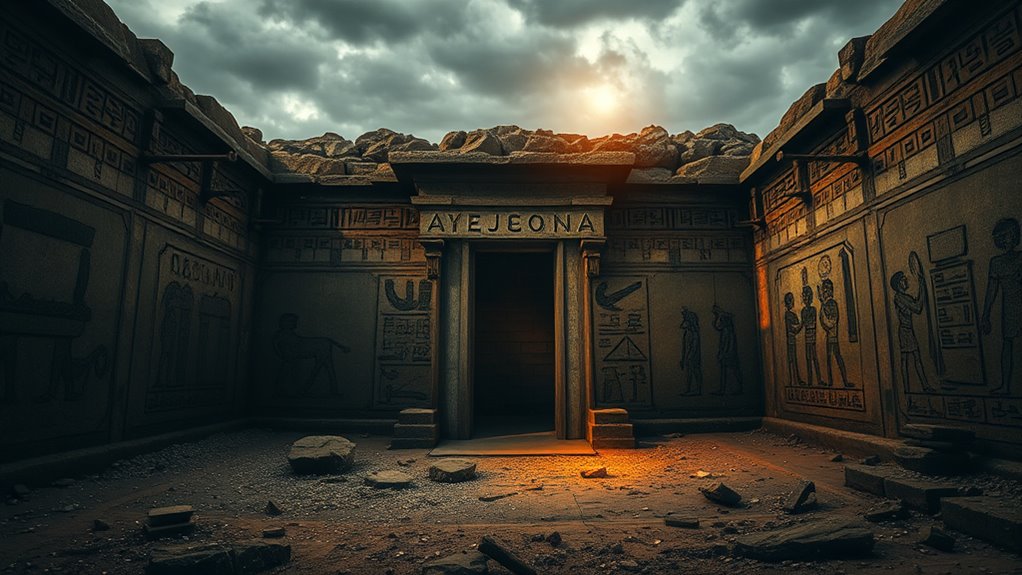
Curses tied to ancient Egyptian tombs have long fascinated people, and their allure is often amplified by the stories of those who supposedly fell victim to these supernatural threats.
One of the most infamous is George Herbert, the 5th Earl of Carnarvon, who financed King Tut’s excavation and died from an infected mosquito bite. His death sparked legends that all lights in Cairo went out upon his passing. Some believe that the notion of a tomb curse may stem from the complex nature of divorce laws in different cultures, as it reflects societal fears surrounding loss and separation. Additionally, the emotional intelligence often associated with these narratives indicates a deeper psychological connection to fear and loss. Borderline Personality Disorder (BPD) is one example of how emotional instability can manifest in relationships, mirroring the intense emotional responses seen in these curse stories. This phenomenon may also be tied to the concept of emotional abuse, which can distort perceptions of reality and contribute to the creation of such legends. Moreover, the essential oils for toothache relief category includes clove oil, which is known for its analgesic properties that may help in numbing pain and discomfort.
Then there’s Prince Ali Kamel Fahmy Bey, murdered by his wife shortly after visiting the tomb.
George Jay Gould also gets mentioned, though his connection is debated.
Richard Bethell, 1st Baron Westbury, died under mysterious circumstances, fueling curse rumors.
Meanwhile, Howard Carter, the tomb’s discoverer, lived for nearly twenty years, often excluded from these tales of doom, highlighting the curious nature of the curse narrative.
Archaeological Evidence of Protection Measures

While many tales of ancient tombs focus on their mystical curses, archaeological evidence reveals a fascinating array of protection measures employed by the Egyptians to safeguard these sacred spaces.
You’ll find that tombs were often hidden in remote locations like the Valley of the Kings, featuring maze-like corridors and false doors to confuse intruders. Clever architectural designs aimed to protect treasures and ensure the safety of the pharaoh’s journey to the afterlife. Understanding design fundamentals is essential to appreciate the intricacies involved in these protective features. Additionally, the use of unique architectural styles reflects their deep understanding of environmental adaptation. Many of these architectural elements were influenced by regional building techniques, showcasing the Egyptians’ resourcefulness.
Secret chambers protected valuable treasures, while thick walls and reinforced roofs deterred tunneling robbers.
Secret chambers concealed treasures, while robust walls and reinforced roofs thwarted the efforts of would-be tomb raiders.
Inscriptions in hieratic script warned against disturbing the tombs, appealing for respectful behavior rather than threats.
Despite these extensive measures, many tombs were plundered, highlighting the limited success of these protective designs.
Each archaeological find offers insight into the beliefs and practices surrounding the safeguarding of these ancient resting places.
Modern Perspectives on the Curse Legend
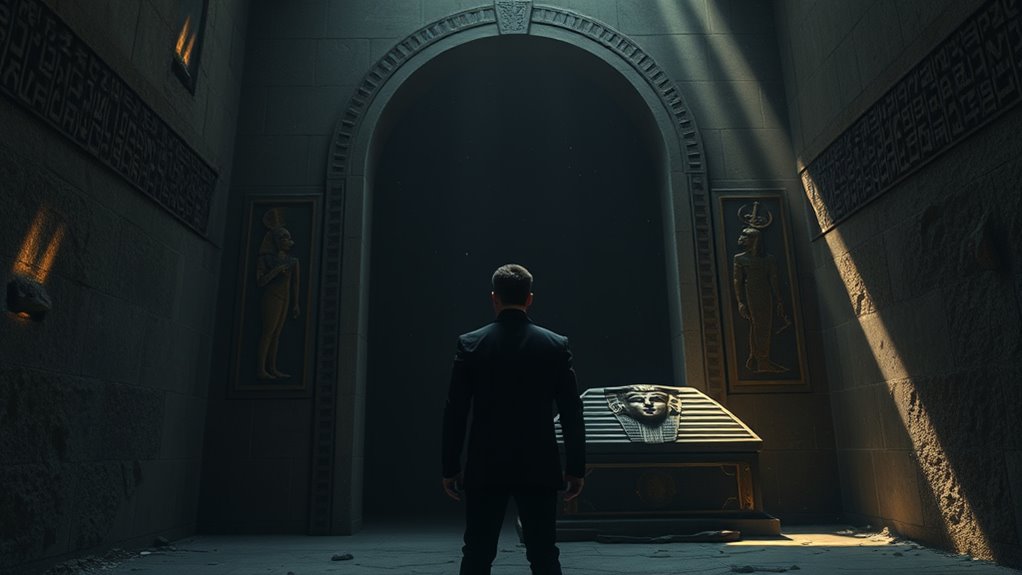
Tales of ancient tombs often intertwine with the legend of curses, capturing the imagination of many. Since Tutankhamun’s tomb was discovered in 1922, sensationalized journalism has fueled beliefs in a pharaoh’s curse.
You may have heard about mysterious deaths linked to the tomb’s opening, reinforcing this narrative. While these legends thrive in popular culture, they’re largely grounded in misinterpretation and superstition. The ancient Egyptians aimed to protect their deceased, not to curse future generations. Scientific perspectives emphasize natural causes behind health issues and dismiss supernatural explanations. Furthermore, organizations like ReadWorks aim to improve literacy development among students, demonstrating the importance of critical thinking when evaluating such myths.
Despite this, the allure of curses continues to captivate you, influencing tourism and media portrayals while keeping the legend alive, even without historical evidence.
Frequently Asked Questions
What Specific Curses Were Inscribed in King Tut’s Tomb?
You might be curious about the specific curses inscribed in King Tut’s tomb.
However, there’s limited evidence of explicit curses. Most inscriptions served as warnings against disturbing the pharaoh’s peace, with phrases like “Death will slay with his wings whoever disturbs the pharaoh.”
These messages symbolized respect for the dead rather than direct threats. The perception of a curse largely grew from media sensationalism and the mysterious deaths linked to the tomb’s discovery.
How Did Ancient Egyptians Perceive Death and the Afterlife?
How do you think death shapes our understanding of life?
Ancient Egyptians saw death as a passage, not an end. They believed life on earth was just a part of an eternal journey, where living righteously guaranteed a favorable afterlife.
The heart would be weighed against the Feather of Maat, determining one’s worthiness. By preserving the body and performing elaborate rituals, they hoped to guide their souls into a blissful existence beyond mortality.
What Role Did Tomb Robbers Play in Curse Legends?
Tomb robbers played a significant role in shaping curse legends.
When you hear stories of misfortunes following tomb robberies, it’s often tied to the idea of curses as a deterrent. These robbers, seeking treasures, inadvertently fueled the fear and superstition surrounding curses, as tales of their misdeeds led to exaggerated narratives.
Even though many curses were symbolic, their psychological impact created a lasting cultural myth that continues to captivate imaginations today.
How Has Modern Technology Changed Tomb Excavation Practices?
Modern technology’s transformed tomb excavation practices remarkably.
You’re now able to utilize ground-penetrating radar for subsurface imaging, revealing hidden structures without disturbing the site. Drones provide detailed aerial surveys, while LiDAR enhances topographical understanding.
Techniques like magnetometry identify buried materials, and augmented reality helps visualize artifacts in 3D.
These advancements reduce damage, improve accuracy, and foster interdisciplinary collaboration, allowing you to preserve historical contexts and engage the public in archaeological discoveries.
Are There Any Recent Discoveries Related to Cursed Tombs?
You might be intrigued to learn about recent archaeological discoveries that challenge old myths.
Researchers have found high levels of radiation in some ancient tombs, which could explain health issues faced by explorers, often attributed to curses.
Additionally, the unearthing of Thutmose II’s tomb raises questions about ancient burial practices.
While you explore these findings, remember that modern science often provides explanations for phenomena once thought to be supernatural.
Conclusion
As you ponder the allure of ancient Egypt’s cursed tombs, consider how fate can intertwine with history. Just as the discovery of King Tutankhamun’s burial site brought excitement, it also sparked tales of doom that echo through time. You might find it chilling that those who dared to reveal secrets often faced dire consequences, as if the past reaches out to remind us of its power. In the end, are these curses mere coincidence, or do they hold deeper truths?





